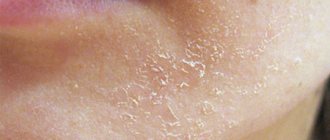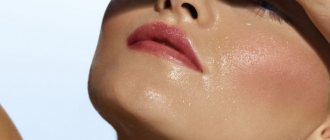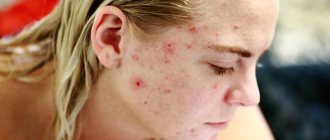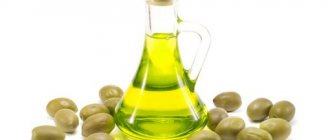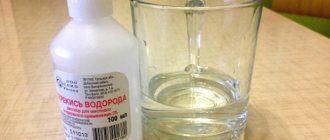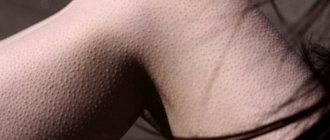Signs and origins of oily facial skin
Oily skin is the result of overproduction of oil by the sebaceous glands. These glands are located under the surface of the skin.
Sebum is a substance made up of fats. It's not too bad as it protects and moisturizes the skin and keeps the hair on your head shiny and healthy.
Too much sebum, however, can lead to oily skin, which can lead to clogged pores and acne.
The occurrence of comedones (blackheads), fatty gland cysts, and seborrhea is also not uncommon. The skin is similar to an orange peel because it has pores.
An undeniable advantage for people with oily skin is that wrinkles begin to appear later.
The epidermis shiny from grease is an unpleasant phenomenon for its owners. Due to the excessive work of the fat glands, a rough, porous texture with an unhealthy tone and a greasy sheen is formed on the skin; the surface of the skin can be overdried, like parchment.
Genetics, hormonal changes, or even stress can increase sebum production.
Oily tissue on the face is localized in the T-zone: forehead, chin and nose. On the body, the greasy epidermis is located on the back and chest. The properties of oily skin also appear on oily hair on the head.
This happens for the following reasons:
- Genetically determined. Under these circumstances, the epidermis is oily throughout life.
- Adolescence. Teenagers are familiar with the manifestations of oily skin, which by the age of 25-30 becomes combination.
- Intensive work of fat glands. This is associated with an inherited predisposition to oily skin, disrupted processes in the gastrointestinal tract (cholecystitis, colitis, constipation), and hormonal changes. The reason for the excessive production of fat on the skin surface is diet (addiction to spicy, fatty, starchy foods, alcohol, soda), work at elevated temperatures, being in a room smoked by cigarettes, under UV radiation.
- Hormonal. This happens during puberty and the 2nd phase of the menstrual cycle. Hormonal disruption occurs during menopause, pregnancy, and stress. This also occurs due to treatment with hormones or their sudden use, or prolonged use of oral contraceptives.
- Disorders in the functioning of the endocrine system. This occurs when, with hypothyroidism, both dry skin and oily epidermis on the face are noted.
Reduced immunity also affects the appearance of the sebaceous surface of the epidermis.
How to remove acne?
Acne can be a symptom of a disease (usually associated with the gastrointestinal tract), but most often it appears as a result of improper skin care. If you normalize digestion, then harmful substances will be eliminated from the body naturally, and not form acne.
Acne can also - if corrected, the skin will soon become clear.
Regular cleansing of the skin with special products will help reduce the risk of acne formation.
General rules of care
There are only a few rules:
- use of mild cleansers;
- wash your face at least twice a day (morning and evening);
- You need to wash your face with cool or warm water, but not hot;
- choosing skin care products that suit your skin type;
- regular peeling;
- constant hydration.
What to wash your face with?
Oily skin is prone to acne as excess oil clogs pores and attracts dust and dirt. It follows that cleansers are especially important.
For oily skin, washing with plain water is not enough; you should regularly use a cleansing foam that is suitable for daily use. After removing makeup, you should additionally wipe your face with toner.
Treatment with pharmaceuticals
It is better to purchase skincare cosmetics for problem skin at a pharmacy , as they sell products that do not mask the problem, but eliminate it. It is advisable to choose a set from one manufacturer. It should include provisions for:
- daily cleansing;
- deep cleansing;
- toning;
- hydration;
- sun protection (even in winter);
- recovery.
The rest can be bought at a regular cosmetic store.
If you need a remedy to treat acne, then for oily skin you need to choose those gels and ointments that are applied pointwise. Otherwise, it will cover the skin with an imperceptible film, which will soon become greasy.
Pharmacy products for problem skin are described in the video:
Homemade mask recipes
There are many recipes for face masks aimed at drying out oily skin. They involve the use of inexpensive products and simple application techniques.
- Activated carbon is an absorbent that has cleansing and anti-inflammatory properties and regulates the functioning of the sebaceous glands.
Grind 1 tablet of coal into powder, add to 1 tsp. gelatin, dilute in 1 tbsp. l. water and stir thoroughly. Heat the resulting mass over a fire or in the microwave, and then, when it has cooled, apply an even layer to the steamed skin of the face using a brush. From the moment the mask dries, you need to wait 15 minutes and then carefully remove it. Can be used once, but weekly repetition gives the greatest effect. - Cleansing kefir mask . For it you need to mix 2 tbsp. l. kefir, 1 tbsp. l. honey and 1 beaten egg yolk, then apply the mixture to your face for half an hour, then rinse with warm water and treat the skin with tonic.
- Strawberry peeling mask . Crush a few fresh strawberries into a porridge and apply to the skin of the face with massaging circular movements, as if it were a scrub. Leave for 20 minutes, rinse with cool water.
- The famous cucumber mask is good for oily skin and will help out those who are too lazy to calculate proportions and mix ingredients.
Recipes for homemade masks for problem skin with acne are described in the video:
Folk remedies
The most effective folk remedies for oily skin include clay masks, scrubs made from oatmeal or ground coffee, and herbal decoctions for washing.
Among folk recipes you can find those containing alcohol - in fact, they are not suitable, since alcohol will provoke active production of sebum, that is, it will lead to the opposite effect.
What tests should I take?
If your skin remains oily despite proper care, you should contact an endocrinologist who will prescribe certain tests. The issue may be a hormonal imbalance, but only a doctor will be able to determine what exactly is wrong with the hormones and how to fix it.
Oils for oily skin
Oil formulations are used instead of night cream. They are applied in a thin layer to a clean skin surface.
Oils act on pores clogged with dirt and hard fat, regulate sebum production, and affect cell regeneration.
Which oils to use? Here is their list:
- Hazelnut in pure form or as part of other oils. Under the influence of the product, the surface of the skin is cleansed, smoothed and restored, the pores are tightened.
- Grape seeds, after which the surface of the dermis looks moisturized and without noticeable pores.
- Berries, buds, black currant leaves - the product is endowed with antibacterial properties, the skin after it becomes elastic, the tone increases.
- Sesame seeds, which influence the normalization of the functioning of the sebaceous glands, narrowing of pores.
- Almond kernels, which cope with cleaning pores and irritation of red spots.
- Tea tree leaves - oily composition saves from acne and normalizes the condition of the dermis.
- Lavender restores dullness to the skin and has an anti-inflammatory effect on the dermis.
Use hazelnut oil (50% of mixing) with the addition of 10% of other selected oils. If you take essential oils (from sandalwood, rosemary, juniper, bergamot, grapefruit, cedar), add 1-2 drops to the base oil composition.
Mistakes in caring for oily skin
What we do wrong if we have oily skin:
First mistake.
Your cleanser is very strong. This is not correct, when women try to degrease their skin using the strongest products, the result usually turns out to be the opposite. At the same time, the skin itself tries to restore sebum and removes even more sebum, thereby covering the face with a thick layer of fat.
Our advice.
It is better to use gentle and mild means, but more often. If you have time, wipe your skin at least 3 times throughout the day; even when you’re busy, it needs to be cleansed. For cleansing, use a lotion or tonic that is designed specifically for oily skin. Such products contain antibacterial substances that prevent inflammation and clogging of pores.
Second mistake.
You squeeze pimples and blackheads too often. Pimples themselves are plugs of dead skin cells and sebum; they block the release of sebum to the surface. Acne takes the place of inflamed pimples. As a result, a small pimple can lead to serious inflammatory processes.
Our advice.
Squeeze out blackheads no more than once a week. The most important thing is to approach this matter correctly. It is necessary to cleanse the skin and soften it using a steam bath with the addition of herbs - chamomile, sage, etc. Then wrap a bandage or cosmetic cotton wool around your finger and, pressing lightly, squeeze out the blackhead. Next, disinfect the area with toilet water or alcohol.
Third mistake.
What are your concerns about the appearance of these pimples? Chocolate, sweets, and sometimes sexual promiscuity or poor hygiene are often to blame. But all these statements are not substantiated at all! All this only leads to unnecessary worries, and, as we know, stress can really negatively affect the condition of our skin and the whole body as a whole.
Our advice.
Don’t pay attention to this, live calmly and don’t think about it, as a last resort, if you have doubts, consult a doctor
Fourth mistake.
You chose the wrong medicine. Many medications, on the contrary, cause acne. If, for example, they contain a lot of vitamin B or iodine.
Our advice.
Look at what medications you have been taking for a long time, read the instructions. If your doctor prescribes you a medicine, ask him about the effect of this medicine on your skin.
Fifth mistake.
You exfoliate too often. Regular exfoliation (or removing dead cells from the surface using exfoliating agents) is beneficial for oily skin and helps remove dead skin cells that clog pores. However, some women exfoliate too often, almost every day. And because of this, the opposite result occurs. The skin begins to secrete even more sebum and becomes even oilier than before.
Our advice.
Peeling is best done no more than 2-3 times a week. After the skin is cleansed, rub in the exfoliating cream in a circular motion. On very dry skin its effect will be more effective. But if you have inflammation and acne, you should not use peeling, because... exfoliating particles will further injure already inflamed areas of the skin and interfere with its healing.
Cosmetic treatments for oily skin
What to do if your skin is oily and acne appears? To eliminate the problem of oily skin, it is permissible to include the following measures:
- using scrubs (from almond, apricot, salt, clay, etc.), this will even out and cleanse the skin;
- the use of peelings with acids (lactic, fruit, pyruvic, trichloroacetic, glycolic, etc.), this will reduce pH, regulate sebum production and reduce the fat content of the dermis;
- consumption of masks (mud, clay, seaweed based), and this will disinfect, soothe the skin surface and remove excess fatty deposits.
It is recommended to contact a cosmetologist in a specialized center to carry out professional cleansing of the epidermis.
Question answer
Do people with oily skin need to use moisturizers?
Of course, oily skin also needs regular moisturizing. With this type of skin, fat interferes with normal cell respiration, pores become clogged, and even collagen production deteriorates. This is why it is important to cleanse the skin surface and then remember to moisturize it.
How to deal with oily shine throughout the day?
To do this, you can use special special napkins. They gently wipe the face, which removes excess sebum without spoiling the makeup. It is also worth carrying powder with you, which after a while can hide the flaw.
Why do many cosmetologists advise wiping your face with paper towels rather than regular ones?
This is explained by the fact that after using a paper towel, a person immediately throws it away. But the towel often remains too wet, and this is an ideal environment for bacteria to multiply. As a result, they end up on the skin surface, which, especially on oily skin, can lead to inflammation.
TOP 5 treatment methods
Skin with excess oil content that is prone to peeling requires additional treatment prescribed by a dermatologist or cosmetologist.
The course of treatment is determined by a specialist after receiving the results of a blood test (glucose, hormones), familiarization with hereditary predispositions, medical history, etc.
The skin surface can be cured of oiliness using hardware measures:
- Laser biostimulation. The beam induces photochemical transformations in the dermis. During the sessions, the epidermis is smoothed, renewed and regenerated. Its elasticity and tone change for the better.
- Microdermabrasion of the dermis. Based on the action of an abundance of microscopic particles. They will polish the skin without pain, eliminate wrinkles, tighten pores, and reduce stretch marks.
- Iontophoresis. It acts on the sebaceous dermis with microcurrents. As a result, blood flow to it, nutrition and microcirculation improves. The treatment restores the skin surface due to deep diffusion of nutrients and eliminates oiliness.
- Cavitation (ultrasonic) peeling. With a shock wave, it cleanses the skin without pain, removes excess sebum from the pores of the hair follicles, and cleanses the keratinized dermis.
- Ultrasonic phonophoresis. Based on mechanical vibrations. The procedure achieves massage, destruction of fibrous tissue, lymphatic drainage (removal of excess fluid). The technique prevents oil from clogging the hair follicles and reduces skin rashes and irritation on the dermis.
Darsonvalization with pulsed high-frequency current affects the skin with vacuum electrodes. As a result, the skin dries out, nutrition and tissue restoration are enhanced.
The doctor decides at the appointment which method of treating oily dermis is suitable for a particular patient.
Expert opinion
- Cosmetologist
- Surgeon
Anna Avaliani
practicing cosmetologist
Reducing the consumption of fats in food will not change the situation much. Be sure to use special products when washing your face; water simply cannot thoroughly cleanse the skin. But do not overdo it, as this can lead to excessive degreasing or drying out.
Aisha Baron
plastic surgeon
To wash your face, use gels, foams suitable for your skin type, and cold water.
Use toners, and moisturize your skin with cream before applying cosmetics. I also recommend not to forget about sunscreen. Cleanse your skin daily in the evening to remove dirt and makeup. And apply the cream again, only at night. These are simple rules, but they will help maintain the beauty of your skin. Proper care and a healthy lifestyle will eliminate excess oily skin. It makes the surface of the dermis attractive, eliminates acne and greasy shine. At the same time, it is not difficult to maintain the visual youth of the face.
To do this, you should follow simple rules and take care of your skin. If you cannot solve the problem of excess fat on your own, you should consult a doctor.
How to treat?
Treatment of oily skin can be carried out either under the supervision of a cosmetologist or at home independently. Before you start work, you need to make a plan and constantly monitor changes, adjusting the scheme if necessary.
At home
There are two main conditions under which the skin will remain in normal condition: care and nutrition . The second includes avoiding fatty, smoked and salty foods, as well as reducing sweets and baked goods in the diet.
Preference should be given to fresh vegetables and grains, and for dessert use those treats that do not contain too much sugar. Soon the digestive system and metabolism will improve, which will have a positive effect on the condition of the skin and its appearance.
You can help the body by properly cleansing the skin of everyday impurities using lotion, gel or foam for washing and regular peelings.
In a video about nutrition that helps reduce oily skin:
Even if oily skin is the result of unfortunate heredity, the situation can be saved with the help of proper care. To achieve the effect, a complex of store-bought products and regular use are enough. In order to achieve greater results, you can add folk recipes to basic care, among which you can choose the most suitable ones.
